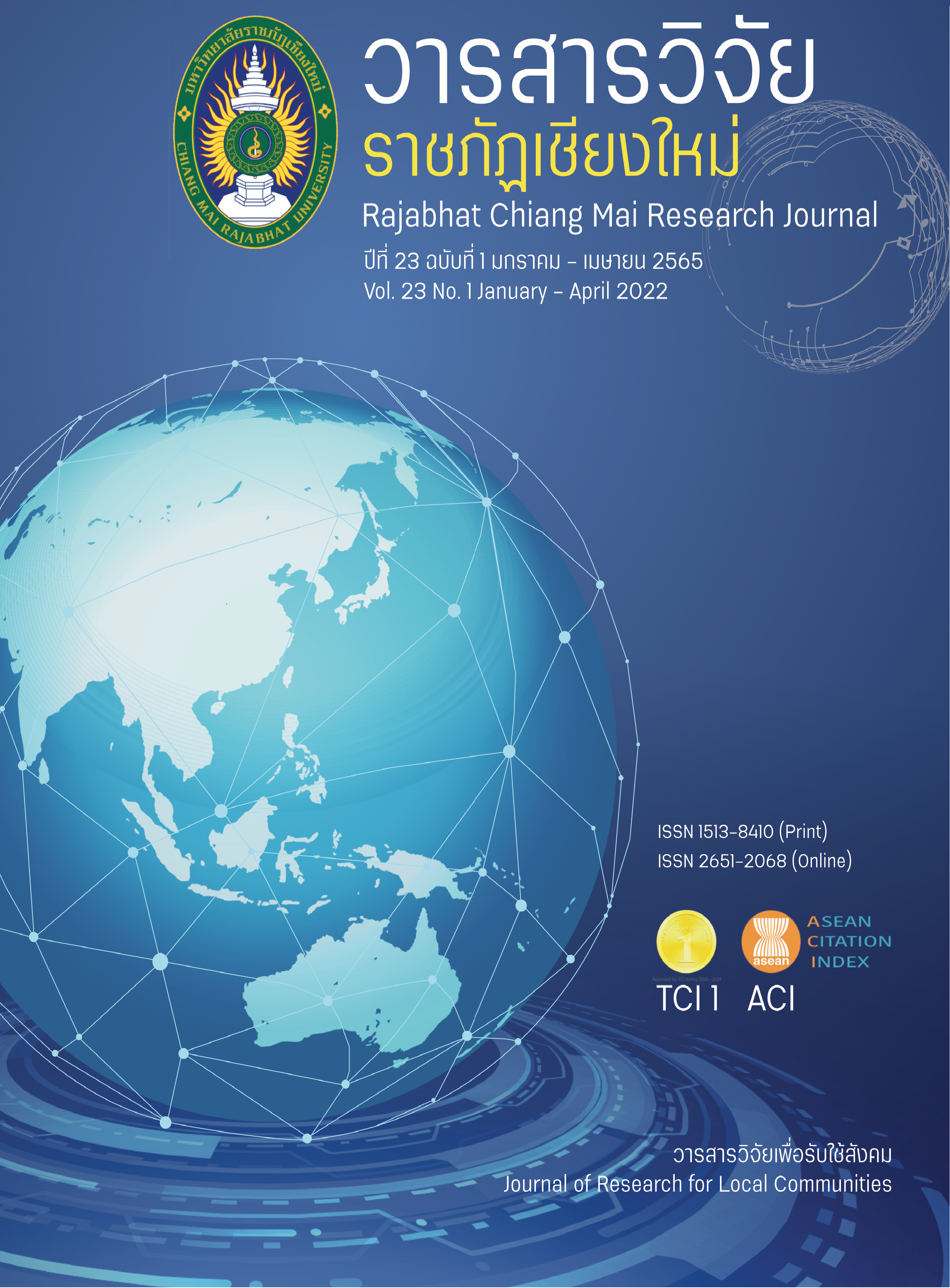The Technology and Inovation Needing Effects Toward Quality of Life in Eldery in Keelek and Saluang Municipality, Mae Rim District, Chiang Mai Province
DOI:
https://doi.org/10.14456/rcmrj.2022.246474Keywords:
Need, Technology and innovation, Quality of life, ElderlyAbstract
The study was to study the need for technology and innovation that affect the quality of life of the elderly and to study the factors affecting the need for technology and innovation among the elderly. This study was for the elderly. In Khilek and Saluang sub-districts, Mae Rim district, Chiang Mai province, 287 people were randomized by multistage sampling. The research tool was a questionnaire. The statistics used in the data analysis were frequency, percentage, mean, and standard deviation. And Pearson correlation coefficient.
The study found that the elderly had a moderate level of need for technology and innovation that affected their overall quality of life. physical and environmental the elderly had a high level of need for technology and innovation which affected their quality of life. The elderly have a moderate need for technology and innovation that affects their quality of life. with the factor of expenditure.
Downloads
References
Bunphadung, S. (2011). Developing the quality of life of the elderly in the local area by using schools as a base According to the sufficiency economy principle (Phase 1), Journal of Suan Sunandha Rajabhat University, Bangkok.
Buppha, B. (2017). Factors Affecting Financial Investment of the Elderly in Sriracha Municipality, Chonburi Province, Journal of Nakhon Phanom University, 7(3), 115-125.
Cronbach, L.J. (1951). Coefficient Alpha and The Internal Structure of Tests. Psychometrik, 16(3), 297 – 334.
Demiris, D. (2009). Older adults’attitudes towards and perceptions of ‘smart home’technologies. Retrieved from https://doi.org.
Department of Provincial Administration. (2016). Statistics on the elderly of Thailand in 77 provinces. Statistics system registers the Department of Provincial Administration. (In Thai)
Ketuwongsa, P. (2016). Open a survey of Chiang Mai elderly leaders, whether they use instant messages or not and how in digital communication systems. Retrieved from www. prachatham.com. (In Thai)
Mihailidis, A. (2010). The Acceptability of Home Monitoring Technology Among Community-Dwelling Older Adults and Baby Boomers, Retrieved from https://doi.org/10.1080/10400435.2008.10131927
Nodthaisong, P. (2018). Elderly present and future. Retrieved from www.nso.go.th.
Oswald, T. & Cotton, S. (2015). Tablets can help elderly cross the ‘digital divide’. Retrieved October 26, 2015, from http://msutoday.msu.edu/news/2015/tablets-can-help- elderly-cross-the-digital-divide/
Pangputiphong, P. (2018). Year 61 Thailand, stepping into an aging society, Ministry of Public Health, Retrieved from https://www.thaihealth.or.th
Phuprasert, P. (2018). Elderly age 4.0, Digital-aware Not being deceived and violated. Retrieved from www.mediafunfacts.in.th.
Prachuapmoh, W. (2018). Aging Society 4.0 Innovation to Support Health and Life. Retrieved from www.thaihealth.or.th
Shamshad, (2017). Asia’s Older People Are Key Players in the Global Development Agenda. Retrieved from https://thediplomat.com/
Smith, A. (2014). Older adults and technology use: Adoption is increasing, but many seniors remainisolated from digital use. Retrieved from http://www.pewinternet.org/2014/04/03/older-adults-and-technology-use/
United Nations. (2018). 2018 UNIDOP Celebrates Older Human Rights Champions. Retrieved from https:// www.un.org/development/desa/ageing/international-day-of-older-persons-homepage/2018unidop.html
Vanichyanukoh, D., Anantho, S., Thongrin, S. (2017). The Process of Internet Acceptance for Developing the Quality of Life of Senior Citizens. Journal of Dhonburi Rajabhat University, 11(2), 60 – 73
Zhang, J. & Umemuro, H. (2012). Older adults’ hedonic and eudaimonic well-being in information and communication technology activities. Gerontechnology 2012, 10(4), 231-243.
Downloads
Published
How to Cite
Issue
Section
License
Copyright (c) 2022 Rajabhat Chiang Mai Research Journal

This work is licensed under a Creative Commons Attribution-NonCommercial-NoDerivatives 4.0 International License.
1. Articles, information, content, images, etc published in the “Community and Social Development Journal” are copyrighted by the Community and Social Development Journal, Chiang Mai Rajabhat University. In order to properly distribute the articles through print and electronic media, the authors still hold the copyright for the published articles under the Creative Commons Attribution (CC BY) license, which allows the re-distribution of the articles in other sources. References must be made to the articles in the journal. The authors are responsible for requesting permission to reproduce copyrighted content from other sources.
2. The content of the articles appearing in the journal is the direct responsibility of the article authors. The editorial board of the journal does not necessarily agree with or share any responsibility.














